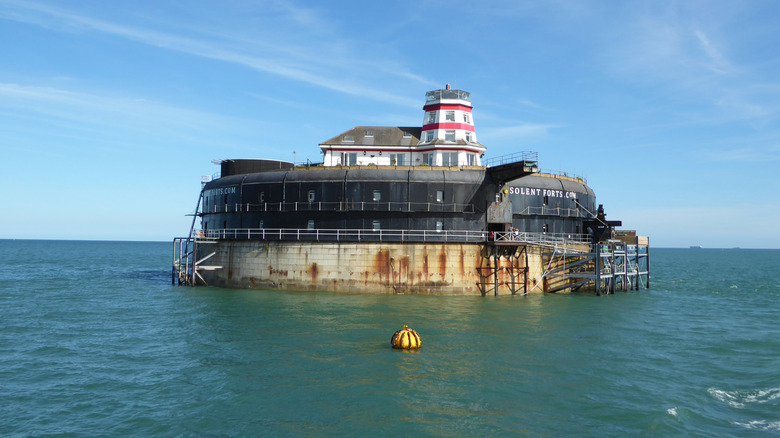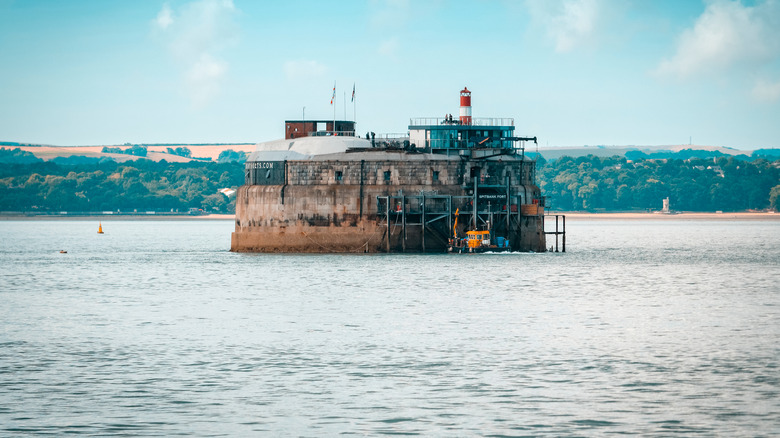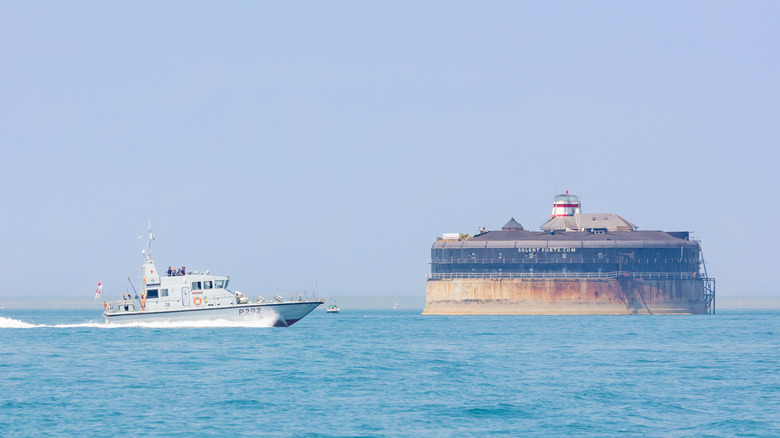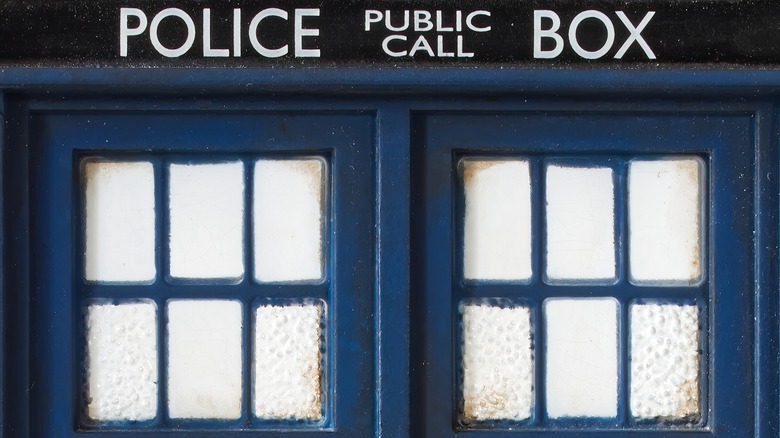The Bizarre Truth About The No Man's Sea Fort
A mile-and-a-half off the Isle of Wight, near England's south coast, a strange tower looms up from the sea. It's round, about 200 feet (61 meters) in diameter, and it's plated in black iron. Small jetties sit at its granite base, while a turret, which, like a lighthouse, rises out of the top (via Royal Naval Museum).
This strange little building in the middle of the sea is No Man's Fort. Built slowly between 1867 and 1880, this fort, like the three other manmade islands in Isle of Wight's Solent Strait, was created to protect the shipyards of Portsmouth from foreign invasion. According to the BBC, it housed naval garrisons through some of the U.K.'s tensest moments, like World War I and World War II. Later, it went through periods of dereliction, hosted an episode of "Doctor Who," was the site of a deadly bacterial outbreak, and is now, incredibly, a luxury hotel.
A massive enterprise
The Solent Forts website tells the incredible story of their construction, miles away from shore. Lord Palmerston, then British prime minister, ordered the construction of five forts in the Solent, the strait between the city of Portsmouth and the Isle of Wight. Portsmouth was a critical naval and shipbuilding hub, he reasoned, and needed the protection. In any case, Napoleon III, the second emperor of France, was building up his navy as fast as he could. All the more reason to keep Portsmouth safe, he said.
It was an unpopular move. The opposition in Parliament called the proposed forts "Palmerston's Follies," according to the Royal Navy Museum. Palmerston died in office in 1865 (per Britannica), but two years later British Navy barges began hauling out granite blocks to begin the construction of four forts: No Man's, Horse Sand, Spitbank (seen above), and St. Helens. Divers helped lower the huge foundation blocks to the seabed. By the time they were completed, in 1880, Napoleon III had long been deposed.
A dungeon in the sea
The British Navy brought heavy artillery to No Man's Fort during World War I, when German U-boats were lurking off the British isles, looking to torpedo ships. The forts saw almost no action, though, until World War II. German air raids over Britain, known as the Blitz, showed how vulnerable the U.K. was to attack, and the No Man's Fort was armed with a bigger garrison, heavier guns, and an anti-submarine boom (per Solent Forts). Life on the fort was miserable between the cold, constant damp, bad food, and air raids. It was so miserable, in fact, that no serviceman who knew how to swim was allowed on No Man's Fort, as anyone who could paddle the mile and a half to land likely would (via Solent Forts).
The forts were decommissioned after the war, but their reputation as bleak, wet prison hulks remained. There was no permanent garrison after 1956, and when the Navy tried to sell No Man's Land in 1963, no one made an offer (via Royal Naval Museum).
Doctor Who and the ruin
No Man's Fort, like its sisters, sat in the sea in grim ruin, its armored plating rusting and its corridors leaky and corroded. The U.K. had gotten rid of its coast artillery in 1956, and there seemed to be no use for the strange round towers in the Solent.
This period would last for decades, into the 1980s, but one happy moment for No Man's Fort came in 1972. The BBC's hit show "Doctor Who," in its ninth season, featured Jon Pertwee as the Doctor. Episode 11, the third in a three-part episode called "The Sea Devils," saw the Doctor held as a prisoner on a dismal prison island while attempting to rescue a friend (via IMDb). Before it was purchased and turned into a luxury hotel, No Man's Fort was best known among Britons for this "Doctor Who" cameo, according to On the Wight.
Diseased and abandoned
The Ministry of Defence finally managed to sell No Man's Fort to a private buyer in 1982, who worked to restore it. The other Solent sea forts were bought up as well. The Solent Forts website states that Spitbank was turned into a museum, although it's not clear how long this venture, or this particular owner's tenure, lasted.
In 2004, a developer named Harmesh Pooni reportedly purchased No Man's Land for £6 million (roughly $5 million USD), hoping to lease it as a venue for special occasions (via Slate). That same year, the fort suffered an outbreak of legionella, a deadly bacterium, which was found to be contaminating pool water on the island. Decontaminating it proved so expensive that the owner had to declare bankruptcy. Per Slate, Pooni was forcibly evicted from No Man's Fort in 2009. Legionella causes Legionnaire's disease, which according to the CDC is a deadly, virulent pneumonia.
And now, a luxury hotel
In 2009, Amazing Venues purchased No Man's Fort and Spitbank with a wild plan in mind. They were on the sea, remote, and had plenty of room — why not make a luxury hotel of them?
So they did. The Solent Forts resort opened in 2012. They're fairly small: Spitbank, for example, has only nine suites for guests. Nevertheless, it's a far cry from the fort's grim past. Accessible by a ferry, which departs from Gunwharf Quay in Portsmouth every day at 12 p.m. and 6:30 p.m. sharp, the hotel has a champagne cellar, a restaurant, a sauna, fishing tackle for guest use, treasure hunts in the fort's deep chambers, a fashionable cocktail bar, and speedboats. "If you've got a particular request, however outlandish it may seem, just ask," reads their website. "If it's possible (and legal) we'll almost certainly give it a go." As of 2022, the Solent Forts website notes that No Man's Fort and Spitbank are both closed due to COVID-19.





